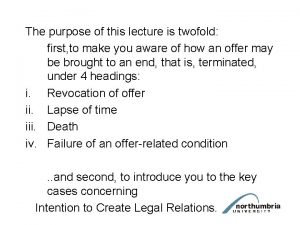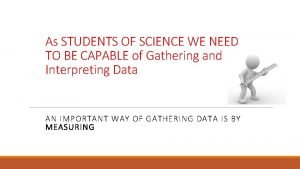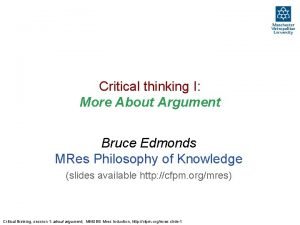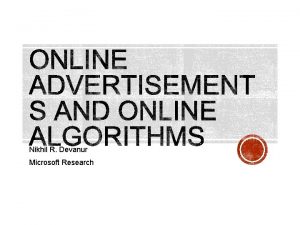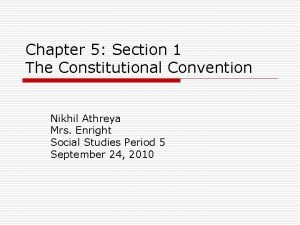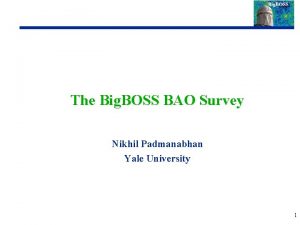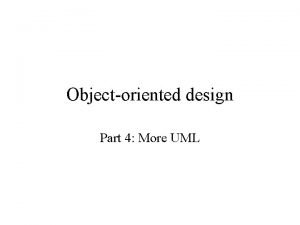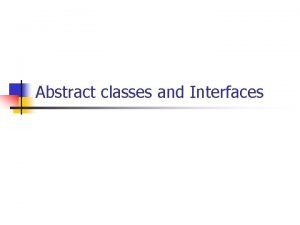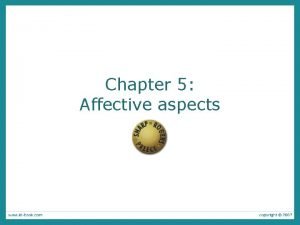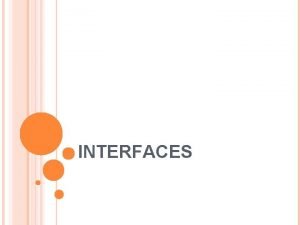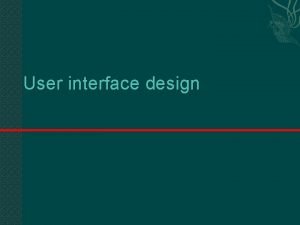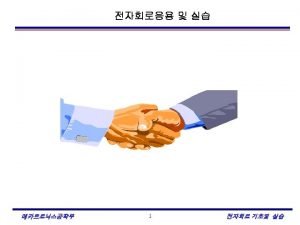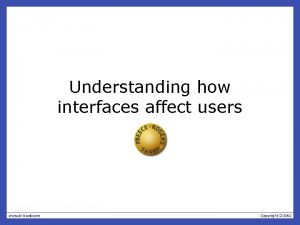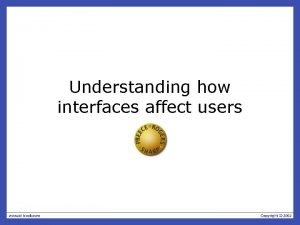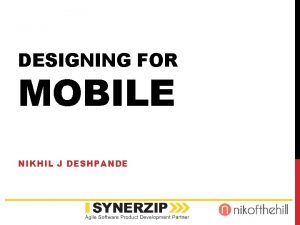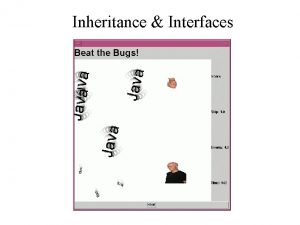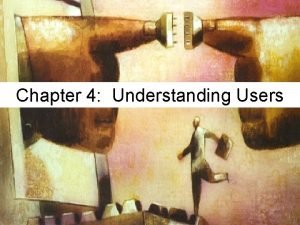understanding how interfaces affect users Andy Edmonds Nikhil






























- Slides: 30

understanding how interfaces affect users Andy Edmonds, Nikhil Iyengar, Sajay Sadasivan, Vladimir Paulen

Overview n n n affective aspects expressive interfaces user frustration anthropomorphism virtual characters: agents

Affective Aspects n n affective = producing emotional response affective behavior could trigger an emotional response from others — e. g. , Sad n , Happy , Trust affective computing – Ability for the computer to recognize and express emotions as humans do

Expressive Interfaces n expressive interfaces can be implemented — visually such as expressive icons , user generated emoticons such as happy : ), Sad : (, Great job : Y, I 1 2 CU 2 nite — audio visually e. g. , using interface agent — audio e. g. , You’ve got mail!, Welcome!, Goodbye, action that cannot be performed

Expressive Interfaces ( contd. . ) n expressive icons — provide feedback e. g. , # the hour glass # the smiling Mac icon indicating that the machine is booting — triggers an emotional response from the user — conveys status of the system, e. g. , dynamic icons like the recycle bin — assist the user in a task, e. g. , interface agents n n spoken messages, e. g. , Microsoft Money, phone agents the more effective the use of imagery, the more engaging and enjoyable it can be (Mullet and Sano, 1995)

Expressive Interfaces ( contd. . ) n n n shapes, fonts, colors, and graphical elements define style of the interface aesthetics have positive influence on user’s perception of usability (Tractinsky, 1997) the key is to have the right balance between and usability and other design concerns like aesthetics. — e. g. , interface agents could prove to be annoying to an experienced user especially when they distract them from their work n absence of balance will result in user frustration

User Frustration n …on the web… gimmicks error messages — designing n n overburdening the user appearance

User Frustration on the Web the 50% rule illustrated with the task fallout in a web-based demo n http: //uzilla. net/uzilla/my/tools/fallout

Banner Frustration - Popups n n Bad banner ads "An i. Village survey found 92. 5 percent of its users thought pop-ups were the most irritating thing about the Web and the ads damaged advertisers' brands. Similarly, an AOL study recently found user satisfaction increased in inverse proportion to the number of pop-ups visitors saw. This prompted the company to cut back on the format. ". . . "i. Village and AOL's decisions to nix (or reduce) usage of an ad format calls a larger issue into question: Have online publishers drafted formal policies or guidelines related to user experience? ". . . "an industry wide lack of policies and guidelines indicates publishers' approach to advertisers and users is ad hoc and reactive. " In Pop-Up Warfare: Is Peace Possible? , Tessa Wegert General dimensions of banner Annoyance

Error Messages n key design heuristics — degrade gracefully — prevent User Error — speak the user’s language

Frustration – Error Messages (contd. . ) n n n n be Courteous avoid terms like fatal, error, invalid, bad, and illegal avoid long codes precision is needed context sensitive help layered presentation – summary detail e. g. , http: //www. web-graphics. com/404. html

Overburdening the User e. g. , upgrading software — results in extended fixing session tweaking preferences, restoring settings n e. g. , missing Plugins on the Web n

Unpleasant Interfaces n n n overloaded flashing gratuitous sound featuritis childish design poor layout

Dealing with User Frustration n users vent it or take it out on other users? venting behavior could be unproductive and unpleasant solution: — Online help such as hints or contextualized advice n should computers say they’re sorry? Opinions!!

Anthropomorphism n n n anthropomorphism - anthropology = study of humans and morphism = having a specified form - it is the propensity people have to attribute human qualities to objects - for example talking toys (Acti. Mates TM- Barney) or trees (Wizard of Oz) well known phenomenon in advertising - drinks, breakfast cereals exploited in human-computer interaction - keywords= motivation & enjoyment - make user experience more enjoyable and motivating (Strommen, 1998), make people feel at ease, reduce anxiety

You Choose • • “Now Chris, that’s not right. You can do better than that. Try again. ” “Incorrect. Try again. ” Which would you choose? Why?

The Debate n n “in favor” of anthropomorphism: - makes system more interactive and fun - strong factor in human motivation - harmless bit of fun “against” - could make people feel anxious or inferior (Shneiderman, 1998), e. g. , screen characters that wave their fingers at the user. - poor anthropomorphic designs can trigger user frustration and anger

Studies on Anthropomorphism n n n computers designed to flatter and praise users had a positive impact on how they felt about themselves (Reeves and Nash) Walker et al study shows that the users spent more time with an anthropomorphic design than a text only design Sproull et al’s studies showed that interaction was high for a talking-face display. But some users felt somewhat disconcerted and displeased. many prefer the more impersonal: - “Incorrect. Try again. ” personalized feedback is considered to be less honest and makes users feel less responsible for their actions (e. g. Quintanar, 1982)

Virtual characters n cartoon and life-like characters appearing on our screens • agents to help search the web, characters in videogames, learning companions in CBT’s, wizards for installations, virtual newscasters, cyber popstars,

Advantages the agents provide a welcoming personality and make the user feel involved with them. n provides for the lack of personal touch in the cyber world. n there can also be ‘intelligent’ functional aspects to an agent. They could communicate with other agents and gather information. "The Semantic Web is an extension of the current web in which n information is given well-defined meaning, better enabling computers and people to work in cooperation. " -- Tim Berners-Lee, James Hendler, Ora Lassila

Disadvantages n n agents lead people into false sense of belief, enticing them to confide personal secrets or expect a human intelligence. agents can be annoying and frustrating causing more harm than good e. g. Clippy in MS Office n the sense of trust developed in personal contact with another person would not exist with virtual agents e. g. e-commerce assistants for transaction?

Miss boo. com Miss boo a sales agent designed to be persuasive and helpful like a sales woman in real world malls.

Conversation with Cybelle n http: //www. agentland. com/

Virtual characters: classification n in terms of the degree of anthropomorphism they exhibit: — — Synthetic characters animated agents emotional agents embodied conversational agents

Synthetic characters -Silas the dog autonomous, with internal states and able to respond to external events (Blumberg, 1996 - MIT)

Animated agents often cartoon-like they play a collaborative role at the interface e. g. Herman the bug (Lester et al, 1997 Intellimedia)

Emotional agents these have a pre-defined personality and set of emotions that the user can manipulate. they could be used as a reflection of the user’s mood. The Woggles, Bates, 1994

Embodied conversational agentsemulate human conversation Human-like body and use gesture or non-verbal communication (facial expressions, winks) while talking. Sophisticated AI techniques used to enable this form of interaction http: //gn. www. media. mit. edu/groups/gn/projects/humanoid/ Cassell, 2000, MIT Rea, real-estate agent, showing a user an apartment

Believable agent believability refers to the extent to which users come to believe an agent’s intentions and personality n Appearance Simple cartoon-like characters are found to be more believable as compared to realistic characters, resembling the human form. n Behaviour How an agent moves, gestures and refers to objects on the screen Exaggeration of facial expressions and gestures to show underlying emotions

An Agent for you n Talking buddy http: //greetings. talkingbuddy. com/texis/open/greetings? edit=read&from=group+2&fromemail=ssadasi@ @clemson. toemail= =sajay@ Youre+the+Best&char=Merlin&message=hi+class+ho http: //greetings. talkingbuddy. com/ clemson. edu&to=HCI+class&toemail sajay@clemson. edu&song=Light+My+Fire&phrase=Youre pe+you+are+having+fun. +no+we+did+not+find+a+better+song
 Sally guzman edmonds school district
Sally guzman edmonds school district Skyward edmonds
Skyward edmonds Chu liu edmonds algorithm
Chu liu edmonds algorithm Edmonds v lawson 2000
Edmonds v lawson 2000 Dr peck edmonds
Dr peck edmonds Mr edmonds meniscus song
Mr edmonds meniscus song Buy side clearing
Buy side clearing Jeff edmonds
Jeff edmonds Citespace download
Citespace download Bruce edmonds
Bruce edmonds Nikhil r. devanur
Nikhil r. devanur Nikhil athreya
Nikhil athreya Nikhil padmanabhan yale
Nikhil padmanabhan yale Nikhil suryanarayanan
Nikhil suryanarayanan Nikhil suryanarayanan
Nikhil suryanarayanan Dr nikhil tandon
Dr nikhil tandon Safety pledge to nikhil
Safety pledge to nikhil Dr nikhil datar
Dr nikhil datar Nikhil gandhi pipavav
Nikhil gandhi pipavav Uml interfaces are used to:
Uml interfaces are used to: Abstract classes in java
Abstract classes in java Multiple document interface
Multiple document interface Bts
Bts Expressive interfaces
Expressive interfaces Communication interfaces in embedded systems
Communication interfaces in embedded systems Operacion de micros e interfaces
Operacion de micros e interfaces Interfaces are syntactically similar to
Interfaces are syntactically similar to Which is not an objective of designing interfaces?
Which is not an objective of designing interfaces? Industrial interfaces
Industrial interfaces User interfaces design dc
User interfaces design dc Gui for r
Gui for r



